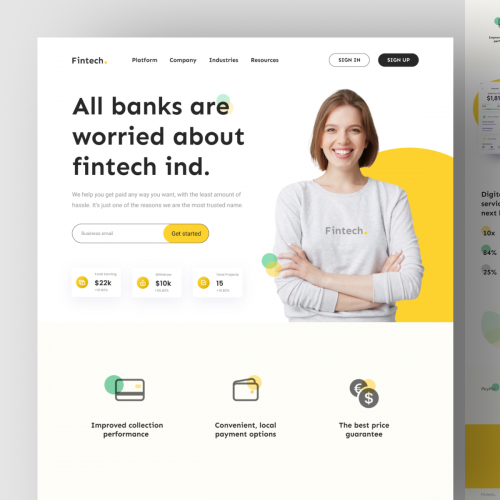Budget-Friendly Website Design Solutions for Small Businesses
Budget-Friendly Website Design Solutions for Small Businesses
Blog Article
Top Tips for Creating an Impactful Web Site Layout That Transforms
To accomplish this, one need to think about a range of elements, including comprehending the target audience, prioritizing individual experience, and optimizing for mobile platforms. The tactical use of compelling call-to-actions and a distinct aesthetic hierarchy plays a vital role in guiding users via their journey.

Understand Your Target Audience
Comprehending your target market is essential to effective web site style, as it prepares for creating an interesting individual experience. Recognizing who your users are, including their demographics, preferences, and behaviors, makes it possible for developers to customize the web site's material, design, and capability to meet details requirements.
Performing thorough marketing research is important in this procedure. Studies, meetings, and analytics can give beneficial understandings into user assumptions and pain factors. By assembling this information, developers can produce user characters that represent various segments of the target market, making sure that style decisions are informed and relevant.
Moreover, understanding the target audience aids in picking proper layout elements such as color plans, typography, and images that resonate with customers. A website that talks straight to its audience fosters a sense of connection and trust fund, urging longer visits and greater conversion rates.
Inevitably, a user-centered approach to site layout not only boosts customer complete satisfaction but additionally sustains organization objectives by driving engagement and loyalty. By prioritizing the requirements and preferences of the target market, a web site can efficiently serve its function and achieve desired end results.
Prioritize User Experience
To boost the total efficiency of a web site, prioritizing individual experience (UX) is crucial (Website Design). A properly designed UX makes sure that site visitors can navigate the site effortlessly, discover information quickly, and involve with material meaningfully. This brings about raised individual complete satisfaction and higher conversion rates
Begin by carrying out instinctive navigation. Menus should be rationally structured, enabling users to situate crucial areas of the site with very little effort. Consistency in style components, such as color schemes and font styles, promotes experience, which is crucial for keeping individual engagement.
Furthermore, consider the packing speed of your internet site. A hold-up of simply a couple of seconds can cause significant drop-offs, as customers are much less likely to wait for a slow-loading web page. Simplifying pictures and maximizing code can enhance performance and maintain site visitors.
By focusing on user experience, you not just produce an extra satisfying setting for visitors however additionally reinforce your brand name's integrity. Eventually, a focus on UX is an investment in the long-term success of your website.
Optimize for Mobile Instruments
Enhancing for mobile devices is critical in today's electronic landscape, where a raising number of individuals gain access to websites via mobile phones and tablet computers. A mobile-friendly layout not only improves individual experience but additionally plays a significant function in boosting click for source search engine positions. To accomplish this, it is important to embrace a receptive style that automatically adapts to different display sizes and orientations.

Loading rate is one more critical element; mobile customers are usually less client and anticipate quick accessibility to information. Maximize images and leverage web browser caching to boost efficiency. Examination your internet site on several gadgets and screen resolutions to determine and fix any kind of potential usability problems. By prioritizing mobile optimization, you ensure that your site remains affordable and effectively involves a more comprehensive audience.
Use Engaging Call-to-Actions
A site's performance frequently hinges on its capability to direct visitors towards preferred activities, making compelling call-to-actions (CTAs) essential elements of style. CTAs work as the crucial points that direct individuals to involve with the website, whether that indicates making a purchase, authorizing up for an e-newsletter, or downloading and install a resource.
To click over here now create reliable CTAs, quality is extremely important. Use concise language that clearly interacts the activity you want the user to take. Phrases such as "Begin," "Subscribe Free," or "Store Now" not just communicate urgency yet likewise eliminate ambiguity. The placement of CTAs is equally vital; they need to be purposefully positioned throughout the webpage to ensure they are quickly visible, specifically in high-traffic locations.
Moreover, the layout of CTAs need to stand apart without being obtrusive. Utilize contrasting shades and clear font styles to guarantee they record focus. In addition, think about making use of directional signs, such as arrows or photos, to assist customers toward these buttons. By focusing on these elements, businesses can significantly improve individual engagement, driving conversions and ultimately achieving their web site's objectives.
Focus on Visual Hierarchy
Effective site style relies greatly on a well-structured aesthetic hierarchy that guides users with content seamlessly. By arranging components in a fashion that prioritizes information, designers can improve individual experience and facilitate decision-making. This entails making use of size, color, comparison, and spacing purposefully to draw attention to the most crucial elements of a web page.
The use of bigger look at this now fonts for headings and subheadings establishes a clear difference in between different areas, enabling individuals to scan content easily. Furthermore, utilizing contrasting colors for switches and calls-to-action can catch individual attention and urge interaction. Whitespace is another vital component; it avoids mess and allows individuals to concentrate on crucial messages without distractions.
Photos and graphics need to match the text while additionally sticking to the well-known pecking order, strengthening the general message (Website Design). Uniformity in layout components, such as color pattern and typography, additional strengthens the visual power structure, making navigation instinctive

Verdict
In final thought, efficient web site layout requires a detailed understanding of the target audience, prioritization of individual experience, and mobile optimization. Inevitably, a well-executed site style serves as a vital element in driving user actions and accomplishing business objectives.
Report this page